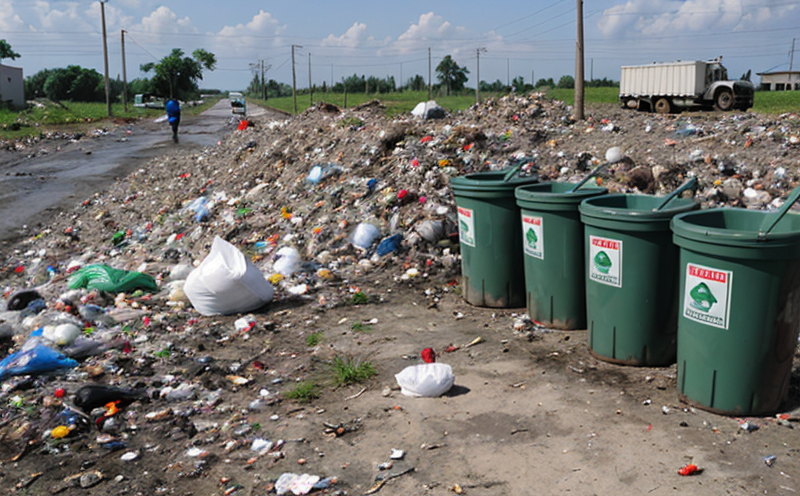ASTM D6239 PCBs in Solid Waste Test
The ASTM D6239 standard method is a critical tool used by environmental laboratories to determine the presence and concentration of polychlorinated biphenyls (PCBs) in solid waste samples. This test is particularly important for industries dealing with hazardous waste management, recycling facilities, and municipalities responsible for landfill operations.
Polychlorinated Biphenyls are a group of chemicals that were widely used until the 1970s due to their stability and insulating properties. However, they are now recognized as toxic substances and are strictly regulated under various international standards like the Stockholm Convention on Persistent Organic Pollutants (POPs). The detection of PCBs in solid waste is essential for compliance with these regulations.
The ASTM D6239 test involves several steps, including sample preparation, extraction, cleanup, and analysis using gas chromatography. This process ensures accurate quantification of PCB congeners within the specified limits set by regulatory bodies. The method covers 17 specific PCB congeners, which are known to be persistent in the environment.
Quality managers and compliance officers rely on this test to ensure that their waste management practices meet environmental standards. By detecting trace levels of PCBs, they can take necessary actions to prevent contamination of soil, water, and air. R&D engineers use ASTM D6239 as a baseline for developing safer alternatives or recycling processes.
For procurement teams, this test helps them select suppliers who adhere to stringent environmental regulations. This ensures that any waste materials used in manufacturing processes do not inadvertently introduce hazardous substances into the environment.
The importance of ASTM D6239 cannot be overstated, especially as regulatory scrutiny increases and public awareness grows regarding the dangers posed by PCBs. The test plays a pivotal role in maintaining environmental integrity across various sectors including electronics, chemical processing, and construction.
Given the complexity and sensitivity of the test, it is crucial to partner with a laboratory that has expertise in handling hazardous materials safely and efficiently. Our facility adheres strictly to all safety protocols and uses state-of-the-art equipment to provide reliable results.
- Sample Preparation: Ensures accurate extraction of PCBs from solid waste samples.
- Cleanup Steps: Removes matrix interferences, ensuring precise quantification.
- Analysis Method: Gas chromatography with flame ionization detection (GC-FID).
- Regulatory Compliance: Ensures adherence to international standards like ISO and ASTM.
- Data Reporting: Provides comprehensive reports including raw data, graphs, and interpretations.
Applied Standards
The ASTM D6239 method is widely recognized for its robustness in detecting PCBs in solid waste. It is based on several key principles outlined by the American Society for Testing and Materials (ASTM). The standard specifies detailed procedures for sample preparation, extraction techniques, cleanup processes, and analytical methods.
One of the primary goals of ASTM D6239 is to provide a standardized approach that ensures consistent results across different laboratories. This helps in achieving uniformity in testing which is crucial for regulatory compliance. Additionally, the method emphasizes the importance of quality control measures such as duplicate sampling and internal standard addition.
Regulatory bodies often reference ASTM D6239 when setting guidelines for PCB concentrations allowed in solid waste. Compliance with this standard not only ensures environmental protection but also supports sustainable waste management practices. Laboratories that adhere to these standards are better equipped to handle increasing demands from clients seeking assurance of compliance.
The application of ASTM D6239 extends beyond mere detection; it plays a vital role in guiding decision-making processes within industries dealing with hazardous wastes. By providing accurate and reliable data, this method enables informed choices regarding waste handling strategies, disposal methods, and recycling initiatives.
Scope and Methodology
The ASTM D6239 standard defines the scope of testing for polychlorinated biphenyls (PCBs) in solid waste. This method is applicable to a wide range of solid waste materials including municipal solid waste, industrial by-products, and hazardous waste streams.
Sample preparation begins with thorough documentation and identification of the waste type before collection. Samples are then homogenized using appropriate techniques suitable for different forms of solid waste (e.g., powders vs. bulk solids). Once prepared, samples undergo extraction using chlorofluorocarbon (CFC) or carbon tetrachloride (CCl4), both of which have been phased out due to environmental concerns but are still used in this legacy method.
Cleanup steps involve filtration followed by dilution if necessary. The cleaned extracts are then concentrated and injected into a gas chromatograph equipped with flame ionization detector (GC-FID). This setup allows for the separation and quantification of individual PCB congeners based on retention times and peak areas.
Results from ASTM D6239 provide valuable insights into the presence and concentration levels of specific PCB congeners. These data are crucial not only for compliance purposes but also for identifying potential sources of contamination, assessing risks associated with waste management practices, and informing corrective actions where needed.





